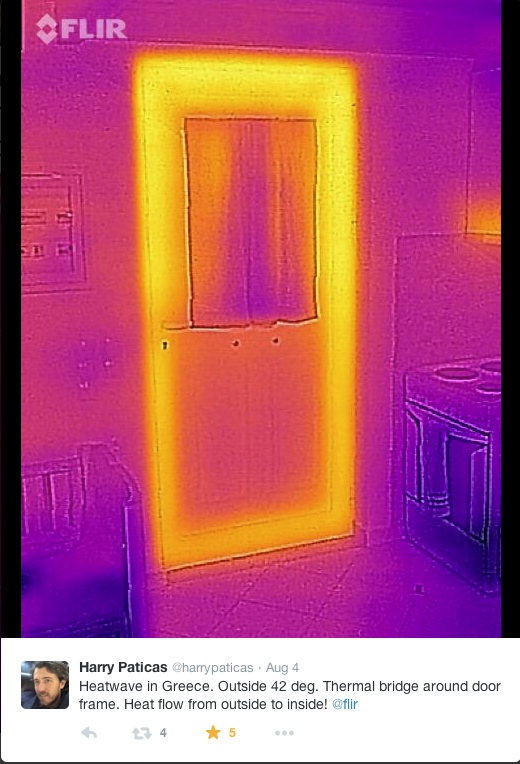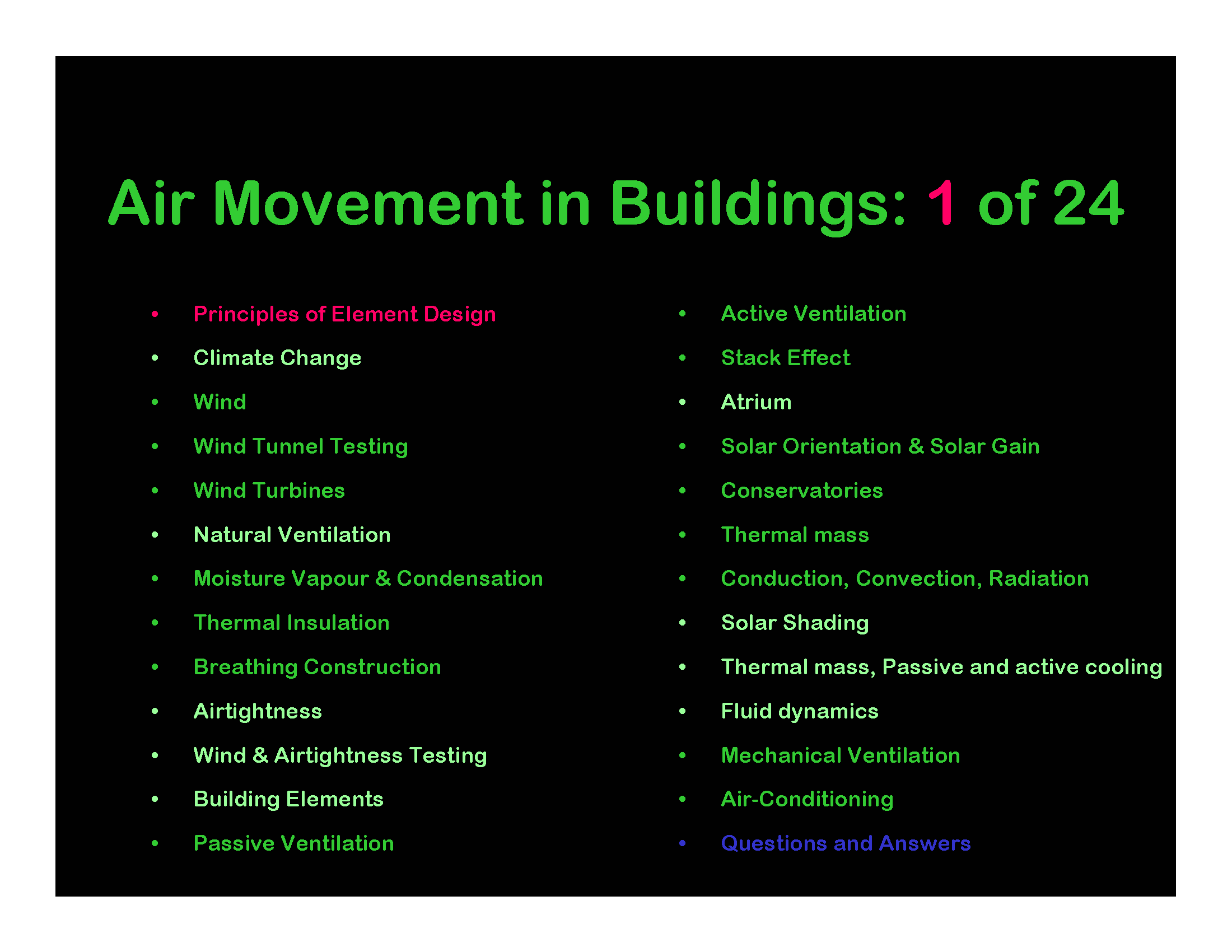A95 Infra-Red Thermographic Surveys (Checklist)
Checklist:
Problems:
- Sun warms buildings during the day, this will be absorbed by heavy weight materials like brick and stone, may take time to disperse, may result in raised temperatures in the scanned images if the scans are taken too soon after sunset.
- Shadows can be cast on the building and may result in differential temperatures in the scanned images if the scans are taken too soon after sunset
- Extending post-mounted cameras can get images of roofs but access for placing the post may be limited
- Heating buildings in summer to carry out IRT surveys will be unwelcome
- Daytime IRT surveys will provide misleading information: e.g. it will show the temperature of the solar warmed roof not the heat loss from inside
Misunderstandings:
- Rooms or adjoining properties heated to different temperature may result in differential temperatures in the scanned images and may be interpreted as different levels of insulation
- Not all anomalies are necessarily a thermal bridge, they may also be different emissivity material at the surface or a bit of both, or a heat emitting radiator hot spot
- Not all cameras are the same: some see through glass and others do not, they see the reflected sky instead
Case studies:
- NHBC publication on Overheating: survey by BRE has misinterpreted hot roof in daytime as heat emerging from inside.
- A research project looking at commercial building improvement under ESOS took day time IRT survey to assess heat loss from the business during the day.
- The pitched roofs showed two temperatures: hotter on the slope facing the sun and colder on the slope away from the sun
- The hot slope and the cold slope and an average temperature of the two slopes would all be misleading
- The cold slope may indicate the heat loss but a roof heated on one slope will warm the attic or top floor or upper levels and may give a misreading measure on the cold slope
Solutions:
- IRT surveys tend to be seasonal to exploit heating season
- Its important to analyse the images in detail after taking them
- Wait sufficient time after sunset before commencing survey
- Record internal room temperatures to enable a thorough analysis of the images
- Take photograph images (colour may be helpful) before sunset to enable analysis of differential emissivity materials on the external face of the building
- Surveys can be carried out either:
- internally looking out: searching for cold spots or
- the 2015 heatwave across mainland Europe saw high external temperatures seen as hop spots from inside (see centre column)
- externally looking in: searching for hot spots
- internally looking out: searching for cold spots or
- Drone remote-controlled multi-rotor helicopter carrying IRT cameras with a steadying gyroscope can access all parts
- But a Voluntary Code of Practice for use of drones suggests getting no closer than 50 m from buildings
Consider:
- Using GBE GBS A95 INFRA-RED THERMOGRAPHY SURVEY Specification
- Use a specialist IR Thermography surveyor to carry out survey and use their help to analyse the results
- Extending post-mounted cameras can get images of roofs
- Consider using remote controlled drone carrying IRT camera to survey roofs that post mounted cannot reach
Avoid:
- Doing surveys immediately after sunset if the building is subject to westerly sun heating its surfaces or objects casting shadow on its surfaces
Minimise:
Substitute:
- Take care to use the right cameras for the task in hand
- Not all cameras are the same: some see through glass and others do not, they see the reflected sky instead
Health:
- Built2Spec project analysed the resolution of IRT attachments and Apps for Mobile Smart phones and recommended minimum distances to get competent results
- They also pointed out that some distances would bring you too close to electrical switch gear and equipment with risk of electrocution
Wellbeing:
- Increasingly IRT is being used to analyse the interiors of buildings where extreme temperature differences are being investigated to discover uninsulated building elements leading to cold feet or hot heads.
- Building overheating affects over 20% of housing, it can lead to ill health and death, IRT can detect overheating which may be due to solar radiation and badly chosen conductivity thermal insulation
Biodiversity:
- Hot spots at roof eaves and ridges on southern to eastern side of buildings, may be bats in maternity roosts, take care not to disturb bat roosts, its illegal and risks a £50,000 fine per bat.
- Bat hibernation roosts will be cooler whilst bats are in torpor and usually occur on northern side of building.
Safety:
- Consider using remote controlled drone carrying IRT camera to survey roofs to avoid putting surveyors at risk
- Use drones with rotor blade covers to minimise risk to humans and animals
- Built2Spec project analysed the resolution of IRT attachments and Apps for Mobile Smart phones and recommended minimum distances to get competent results
- They also pointed out that some distances would bring you too close to electrical switch gear and equipment with risk of electrocution
Precautionary principle:
Appropriateness:
Competence:
- Built2Spec project analysed the resolution of IRT attachments and Apps for Mobile Smart phones and recommended minimum distances to get competent results
- They also pointed out that some distances would bring you too close to electrical switch gear and equipment with risk of electrocution
Effectiveness:
Yardstick:
Maintenance issue:
- IRT surveys can identify weaknesses that can be put right as part of a preventative maintenance regime
- IRT surveys of machinery, motors, etc. can identify overheating, differential overheating, wear, etc. enabling preventative maintenance
- IRT surveys can spot hot water leakage and heat loss concentrations in underfloor heating
Industry/Sector Initiatives:
- IRT surveys by Leeds Met Uni discovered cavity party walls at attic level were overheating which suggests excess heat loss from dwellings through one unregulated and inadequately insulated leaf and chimney effect or hot air rising in the cavity
- This led to the change in the Building Regulation Approved Document L to require party walls to be insulated, and more party wall cavities being filled to stop air movement or thermal flanking.
- IRT surveys can spot convection ‘radiators’ with cold areas caused by air in heating systems floating to tops of ‘radiators’ requiring the radiators to be ‘bled’ or ‘bleeding of air’ from a high level valve.
Information sources:
- See this page right column
© GBE NGS ASWS BrianMurphy
aka BrianSpecMan
13th December 2014 – 18th February 2019
A95 Infra-Red Thermographic Surveys
Images:


GBE CPD: Refurbishment Survey Test & Analysis

GBE CPD: Surveys, Tests, Analysis, Audits, Evaluations

GBE CPD: Air Movement in Building
Page 2: Topics in Series of 24 Seminars
Includes Wind and Airtightness and testing
If you wish to reproduce images, feel free, but please acknowledge the source.
© GBE NGS ASWS BrianMurphy
aka BrianSpecMan
13th December 2014 – 18th February 2019
A95 Infra-Red Thermographic Surveys (Checklist)
See Also:
GBE Checklist
- A90 Performance Specification N#1617
- A91 Prescriptive Specification N#1620
- A92 Package Outline
- A93 Performance Testing Off-site Mock-up Test rigs N#1621
- A94 Airtightness testing on-site N#1622
- A95 Infra-red thermographic surveys (this page) N#1623
- A94 Airtightness testing on-site N#1622
- A95 Infra-red thermographic surveys (this page) N#1623
Adaptation:
- A94 Airtightness testing on-site N#1622
- A95 Infra-red thermographic surveys (this page) N#1623
GBE JARGON BUSTER
- Air/Wind Tightness N#1391
Initials Abbreviations & Acronyms
- IRT
Words & Phrases
- Chimney effect
- Compartment wall
- Infra-red thermographic (IRT) surveys
- Separating wall
- Thermal bypass
- Thermal flanking
- Party wall
GBE CPD
- Air Movement in Buildings Index (F) N#229
- Refurbishment & Retrofit N#1419
GBE LINKS
- Organisation/Website
GBS Green Building Specification
GBS Robust Specification
- Robust Specification Clause
- Robust Specification Work Section
- A95 Infra-red thermographic surveys Specification N#530
GBE LIBRARY
GBE PROJECTS
© GBE NGS ASWS BrianMurphy
aka BrianSpecMan
13th December 2014 – 27th January 2017
URL Links tested: 7th November 2015

